The ASUS ZenFone 2 Review
by Brandon Chester on May 26, 2015 8:00 AM ESTDisplay
In recent times we've seen a tremendous improvement in smartphone and tablet display quality. It began with high end flagship phones, and eventually trickled down to more budget oriented smartphones. Even a $130 smartphone like the 2015 Moto E can have a decent IPS display. However, I'm hesitant to describe the Zenfone 2 as a "budget" smartphone. While I don't mean for the word to have negative implications, it's often interpreted as meaning low quality or cheap. The Zenfone 2 is better described as an inexpensive smartphone. Much like the OnePlus One did when it was released, the Zenfone 2 offers some very serious hardware at a price much lower than what has become the going rate for flagship smartphones.
The display in the Zenfone 2 is a 5.5" 1920x1080 IPS LCD panel. This is another specification that you would expect to see in a $650 flagship device that is instead inside one that starts at $199. While phones are now moving to 2560x1440, on RGB stripe panels I don't feel that there are significant benefits to moving past 1080p even on 5.5" displays. On top of that, a display's resolution is just one of many attributes that contributes to its quality. Color accuracy, brightness, and contrast are all important aspects of a display. To accurately characterize these areas of display performance, we use SpectraCal's CalMAN 5 software and X-Rite's i1Pro 2 spectrophotometer.
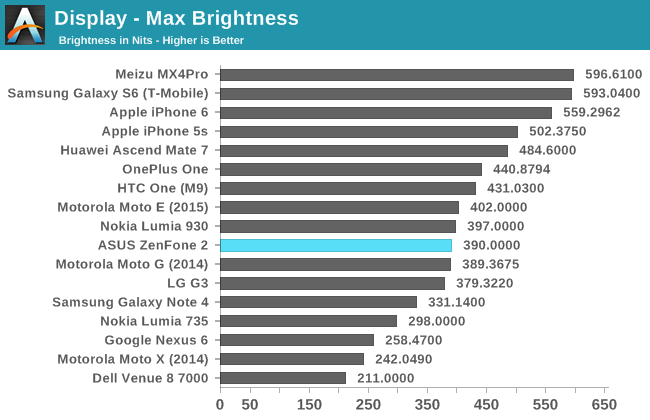
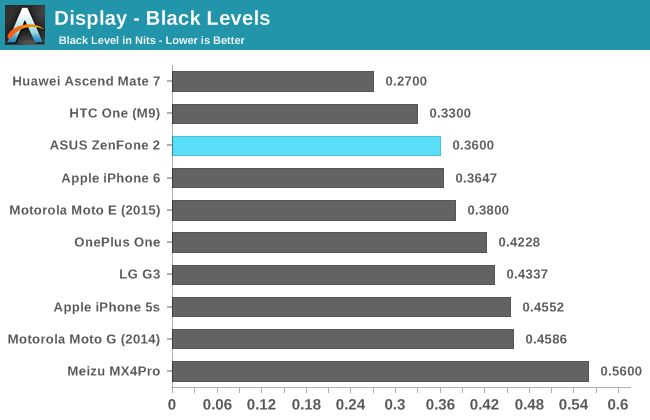
The Zenfone 2 appears to be off to a good start. Black levels are very low among our LCDs, and the max brightness is somewhat low but not terrible by any means. I never had any issues when using the Zenfone 2 outside, although it was definitely not as comfortable as the Galaxy S6.
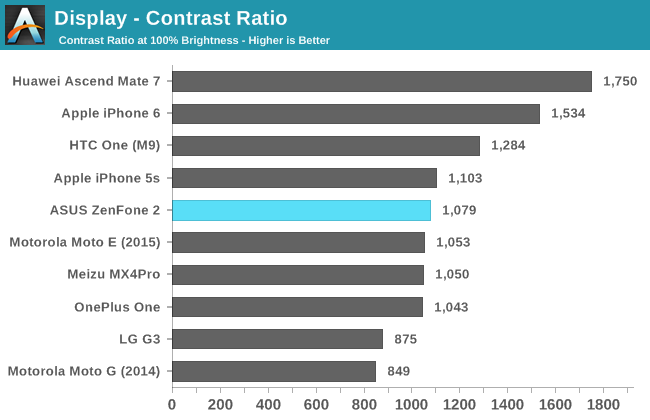
The slightly low max brightness and above average black level results put the Zenfone 2 right in the middle of our LCD devices when it comes to contrast ratio.
Unfortunately, these numbers are somewhat misleading. This is because the Zenfone 2 makes extremely heavy use of dynamic contrast and contect adaptive backlighting (CABC). I have never used another device with such dramatic shifts in backlight power. The best example I've found is when switching from an all black to all white screen at max brightness. While this is obviously an extreme case, it illustrates the behavior that is occuring very well. At the moment you switch to white, the brightness of the display is around 170 nits. Over the next few seconds, that brightness rapidly increases to the 390 nits you see in the results above. This is an enormous jump in brightness, and it's very easy to see with your own eyes.
One last thing I'd like to note about the brightness is that the 100% setting on the built in brightness slider is not actually the max brightness that the display is capable of. The max you can achieve using the slider in the Settings app is 319 nits, which is around 82% of the 390 nit result you can get using applications like Brightness Adjuster from Google Play.
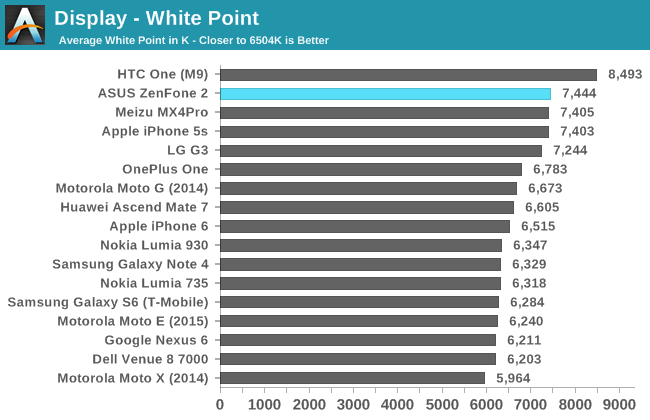
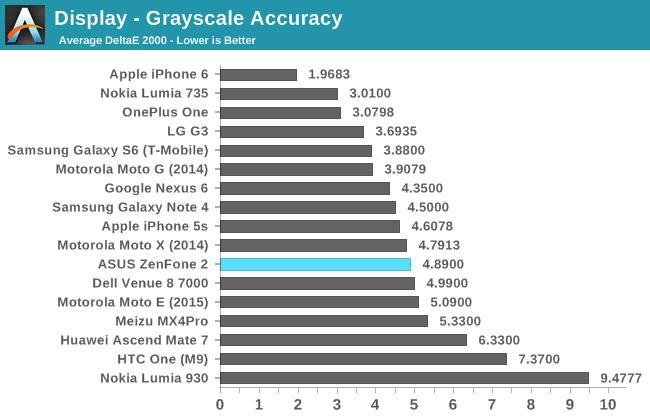
Greyscale accuracy on the Zenfone 2 is very average. The display is too blue, and this can be seen in the reproduction of shades of grey as their brightness goes beyond 15%. The gamma is also extremely irregular, and continually curves upward. This is the result of ASUS's heavy dynamic contrast and CABC. The brightness reductions with darker shades makes the display slower to move out of the shadows, which you can see in the color comparator chart above. Again I must reiterate that the color comparator is a relative color difference, as the bottom half which displays the "target" colors will be impacted by any inaccuracies in the display you use to view it.
Unfortunately, there's not much that can be done to improve greyscale accuracy when CABC is used heavily. Testing with constant APL patterns to try and avoid the brightness shifting did bring the gamma down to 2.4, but because the display still has a blue shift and the gamma is still too high, the average greyscale deltaE was around 4.5 which is still fairly high.
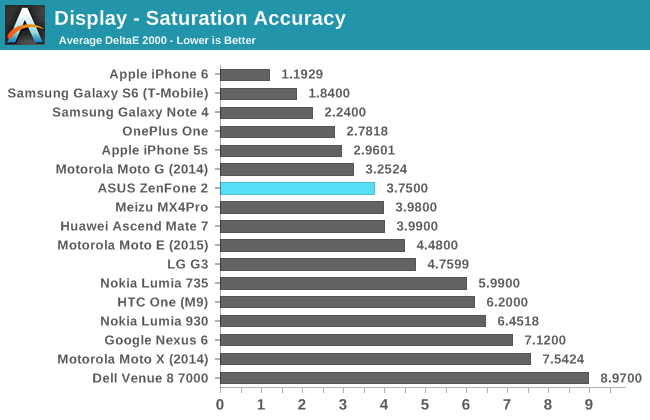
Saturation accuracy ends up being noticeably better than greyscale accuracy on the Zenfone 2. Blue and green manage to stay below the dE target of 3 for all saturation levels, while all the other colors hover somewhere between 4 and 6 on average. An average deltaE across all colors of 3.754 is not terrible by any means, and I don't think Zenfone 2 buyers will have any complaints about the accuracy of primary and secondary colors.
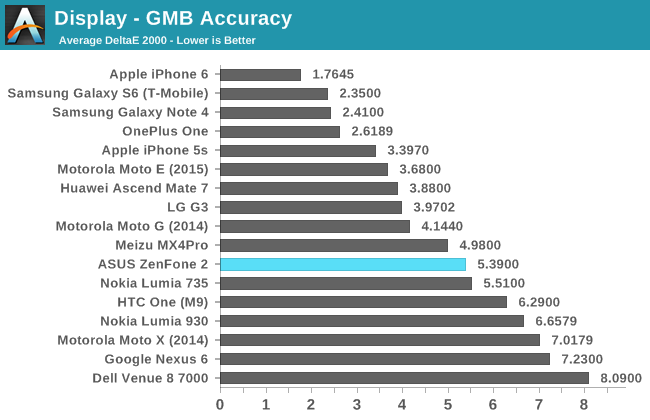
Unfortunately, the inaccurate greyscale and gamma of the Zenfone 2 comes back to haunt it in the Gretag MacBeth ColorChecker test. This test measures the accuracy of various color mixtures that are common in the real world, and the Zenfone 2 misses many of them by a significant degree. What's even more unfortunate is that the highest errors are in mixtures of yellow in red, with the largest error of all the colors tested being light skin tones. If there's one color I want a display to get right, it's skin tones.
The overall display performance of the ZenFone 2 is mixed at best. I'm glad it basically has the full sRGB gamut, and is fairly accurate with saturations of primary colors. However, it doesn't do very well when it comes to shades of grey, and it also has slightly lower accuracy with color mixtures than I had hoped. Devices like the 2015 Moto E show that it's possible to get close to that dE error target of 3 even on an inexpensive smartphone. I would still say that the ZenFone 2 has the best display at this price point purely on the merit of its pixel density, but I really wish that the calibration was better than it is.


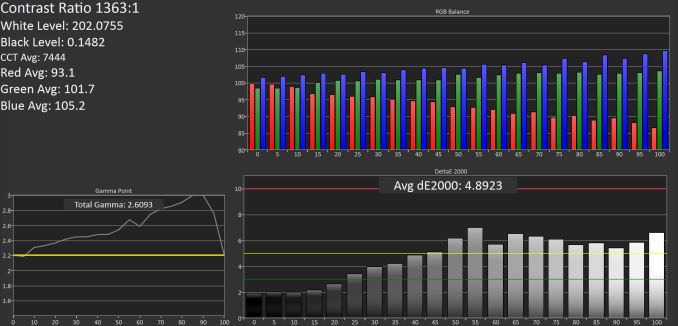

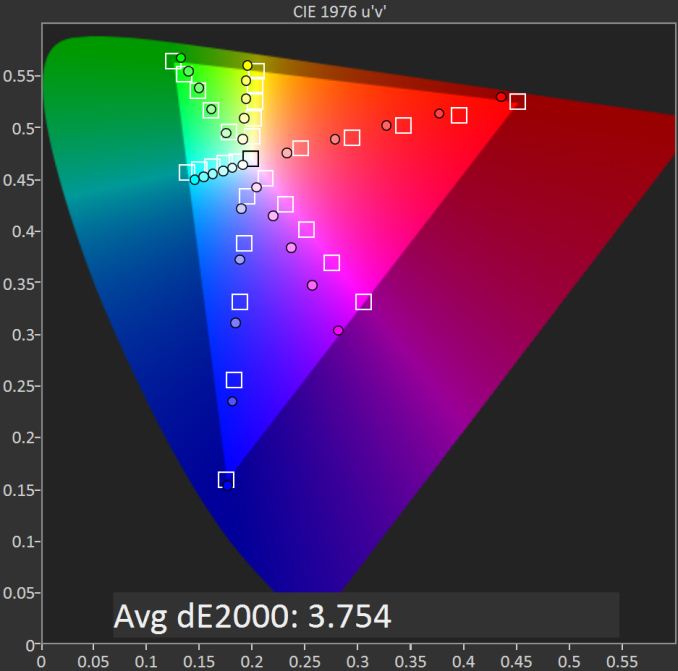









147 Comments
View All Comments
loimlo - Saturday, May 30, 2015 - link
My mom has been using 1st gen, Zenfone 5 for 10 months. ASUS SW update literally broke app compatibility several times during this period. At some time, my mom couldn't disconnect a phone call due to a nasty SW bug! I'd to lock the screen and unlock it again to disconnect. It's not the end of world, but still an alarming for potential 2nd gen, Zenfone 2 buyers. Fantastic HW value, but subpar SW update quality.ketacdx - Thursday, May 28, 2015 - link
I've been using the TW model since long before the NA launch and there have been a lot of software Updates and ZenUI updates but its not like a beta testing thing. They are fixing issues most manufacturers don't bother with. Little things that they are truly optimizing that a normal person would never notice. Aside from my worry about the quality of the gorilla glass when dropped (think nexus 4 outcomes), the QC elsewhere on this things feels prime. I have no concerns.Dawgmatix - Wednesday, May 27, 2015 - link
Are there any phones with arm processors that use the same display? What does their battery life look like? How can we be sure its not the cpu or gpu that is eating up the battery?Brandon Chester - Wednesday, May 27, 2015 - link
Because the SoC power usage is small relative to display power usage on any device during the browser test, and the ZenFone 2 performs worst of all in that test. In tests where the SoC has a greater impact and the display has a lesser one it actually achieves a battery life closer to that of other devices.YOUCANNOTDENY - Wednesday, May 27, 2015 - link
Hello,I had a few observations/questions. I currently own the $199 version of the Zenfone 2, and have not noticed any dynamic contrast or CABC during my time with the device. This may be because I cannot recognize it, but I'm pretty sure something similar is used in my Dell XPS 13 Ultrabook with Intel's HD Graphics drivers (I promptly disabled the dynamic contrast shifts in Graphics Settings). I have, however, turned off "Smart Saving" in Power Management on the Zenfone 2, so that may be what is causing the difference. I am also on the latest 2.17.40.12 software version, which may have introduced changes.
One other thing, I noticed that in the "Splendid" app, owners can change the color temperature of the screen. I immediately noticed the overly cold white point of the screen when I first powered on the device, so I looked to the Splendid app to change the color temperature. I am currently on "Reading Mode" with default settings on the slider, which makes the screen more bearable to my eyes, but I am still unsure of the absolute color accuracy. If at all convenient, would it be possible to rerun screen accuracy measurements in the various color temperature modes offered in the included "Splendid" application? Perhaps, we may be able to find a setting that makes the most of the included panel and does it justice.
Thank you!
Brandon Chester - Wednesday, May 27, 2015 - link
The CABC is there on both models. I made sure that ASUS's power saving features were disabled before I did my testing.While I could try and adjust vaguely labelled sliders in the Splendid app to fix the display's white point, the gamma and greyscale are not possible to fix because of the CABC. Because of this, there's no point in trying to fix the display.
Quad5Ny - Wednesday, May 27, 2015 - link
@Brandon Chester ASUS stock theme looks like a copy of Solstice by John Bussell (@myeverydayghost) who based his theme on Apple's iOS 7. -- http://modmyi.com/info/solstice.php, http://cydia.saurik.com/package/com.modmyi.solstic...UtilityMax - Wednesday, May 27, 2015 - link
The device is not without flaws, but the $200 model seems like a good value. However, the $200 model is a bit dubious proposition considering how close it is to the OnePlus One.Sammaul - Thursday, May 28, 2015 - link
Have the $300 model, and have used a OnePlus...frankly in real world usage it's kind of a wash. OnePlus has better battery life, camera, and speakers. The Zenfone is absolutely quicker and smoother, even with none of the bloat uninstalled. That 2 channel ram in it does wonders compared to other phones I have used.MoJo JoJo - Wednesday, May 27, 2015 - link
I have been using ZenFone 5 for almost 7-8 months. There's only one thing that I don't like about ASUS is that software and software updates.Software:
ASUS ZenUI is buggy as hell. They provide some update to improve one area and ruins the other. They just cannot provide a single, practically stable, update/ROM. It irritates me a lot. Even now most of the ZenFone 2 users are facing so many issues of Shitty Battery" "Force Stop" "Worse Camera" "Heating under normal use (45 deg.C)
Software Update:
Like I said I have been using ZenFone 5 for 7 months, it seems like ASUS is very slow in updating their devices. First, ASUS launched the 1st gen. ZenFone series in July 2014 (in my country) with Jelly Bean 4.3 instead of KitKat 4.4
After almost 2 months of waiting (Aug-September) they released the KitKat update. That update messed up everything, literally everything. It took another 1-2 updates for ASUS to remove the bugs.
In November 2014 they announced that whole ZenFone series will get the Lollipop update in April 2014. It's almost the starting of June but no ZenFone (intel Version) has got lollipop yet! They are just delaying the update to sort out the bugs. But no use. In May Google has rejected their update during verification. So, still waiting for update, which will be 5.0 not even 5.0.2 (Though they have promissed to give 5.1 update, but it will take ages to come).
Moral of the Story:
No doubt, ASUS is great in providing high end specifications. But it ends there itself. The whole experience gets ruined by the software.